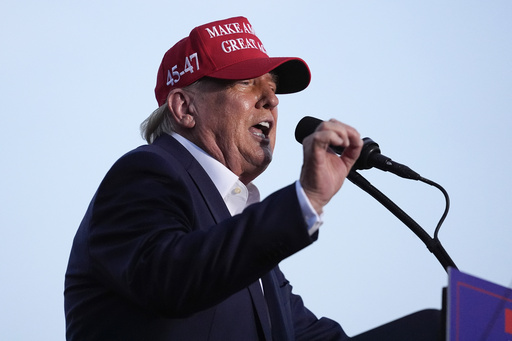MILWAUKEE (AP) — A defiant Donald Trump, having just survived an attempted assassination, enters the Republican National Convention having not yet announced his vice presidential pick.
It remains unclear whether the shooting Saturday at his Pennsylvania rally has changed the former president’s thinking about his potential second-in-command. But his choice now carries considerably more gravity. If a bullet had struck just a little bit to the right, Trump likely would have been killed or seriously injured.
The close call puts in stark relief the significance of a position that is a heartbeat away from the presidency. Trump has repeatedly claimed that choosing someone who was qualified to take over as commander in chief was his top consideration for the role.
“You need somebody that can be good just in case, that horrible just in case,” he said in an interview with “The Clay Travis & Buck Sexton Show” in May.
Hours before the shooting, in an interview before he boarded his plane from Florida, he told Fox News Channel’s Harris Faulkner, “It’s a very important position, especially if something bad should happen — that’s the most important.”
Those on Trump’s shortlist have differing levels of governing experience. Ohio Sen. JD Vance, for instance, has been in office less than two years, while North Dakota Gov. Doug Burgum helms a state with a population (780,000 people) smaller than Columbus, Ohio (908,000). Florida Sen. Marco Rubio has been in politics for decades and is in his third term in the Senate.
He’s talked about ‘The Apprentice’ — but for VP
Before the shooting, Trump had made clear that he wanted to dramatically reveal his pick at the convention, which he said would make it more “interesting” and “exciting.”
“It’s like a highly sophisticated version of ‘The Apprentice,’” he quipped in a radio interview last week, referring to the show he once hosted that featured him firing contestants on camera.
He could announce the pick Monday. But he’s also raised the idea of waiting until later in the week.
Trump and convention organizers have said the RNC’s schedule will go on as planned despite the shooting, with Trump writing on his social media site that he could not “allow a ‘shooter,’ or potential assassin, to force change to scheduling, or anything else.”
“In this moment, it is more important than ever that we stand United, and show our True Character as Americans, remaining Strong and Determined, and not allowing Evil to Win,” he wrote.
He held meetings in the days before the shooting with the top contenders. All have submitted material, including bios and photographs, to convention organizers that can be used to prepare content if they’re picked, according to multiple people familiar with the conversations who spoke on the condition of anonymity to discuss the secretive process.
The private meetings with Vance, Rubio and Burgum were first reported by ABC News.
Nothing was offered during the meetings, one of the people said.
There’s some historical precedent for waiting until the convention
Trump waiting until the convention to choose a running mate is later than usual for recent cycles but is hardly unprecedented.
In 1980, Ronald Reagan negotiated with former President Gerald Ford for hours during the Republican convention in Detroit but settled on his former primary rival George H.W. Bush when those discussions collapsed. Reagan cut it so close that his decision came less than 24 hours before he formally accepted the GOP nomination.
Bush himself waited until the 1988 Republican convention in New Orleans before shocking many attendees — as well as some of the then-vice president’s own top advisers — by picking little-known Indiana Sen. Dan Quayle to be his No. 2, rather than a more established running mate.
Since then, though, the tradition has been to pick a running mate shortly before the candidate’s party’s convention opens.
In 2008, Arizona Sen. John McCain, looking for a way to reset his race against Democrat Barack Obama, picked little-known Alaska Gov. Sarah Palin shortly before the Republican convention opened in Minnesota. He got a bump in the polls that didn’t last.
Democrat Joe Biden tapped then-California Sen. Kamala Harris as his running mate six days before his party opened its convention, which was held mostly virtually due to the coronavirus pandemic. And Trump chose Indiana Gov. Mike Pence in the days before the 2016 Republican convention opened in Cleveland.
___
Associated Press writers Zeke Miller and Will Weissert contributed to this report from Washington.
___
Follow the AP’s coverage of the 2024 election at https://apnews.com/hub/election-2024.
Source: post





